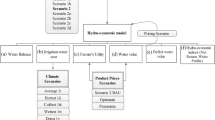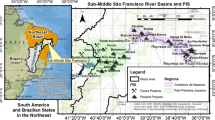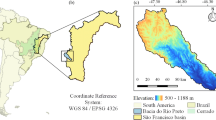Abstract
This study assesses evaporation losses from water reservoirs in the semi-arid Segura basin (south-east Spain), one of the most water stressed European catchments. These losses are evaluated from both the hydrologic and economic perspectives under different water availability scenarios that are based on water policy trends and climate change predictions. We take a multidisciplinary approach to the analysis, combining energy balance models to assess the effect of climate change on evaporation from water bodies, Class-A pan data and pan coefficients to determine evaporation loss on a regional scale, and non-linear mathematical programming modelling to simulate the economic impact of water use and allocation in the basin. Our results indicate that water availability could be reduced by up to 40 % in the worst-case scenario, with an economic impact in the 32–36 % range, depending on the indicator in question. The total annual evaporation loss from reservoirs ranges from 6.5 % to 11.7 % of the water resources available for irrigation in the basin, where evaporation from small reservoirs is more than twice that from large dams. The economic impact of such losses increases with water scarcity, ranging from 4.3 % to 12.3 % of the value of agricultural production, 4.0 % to 12.0 % of net margin, 5.8 % to 10.7 % of the irrigated area, and 5.4 % to 13.5 % of agricultural employment. Results illustrate the importance of evaporation losses from reservoirs in this region and the marked upward trend for future scenarios. Besides, they highlight the extent of the impact of climate change on future water resources availability and use in southern Europe.

Similar content being viewed by others
References
Alcamo J, Döll P, Henrichs T, Kaspar F, Lehner B, Rösch T, Siebert S (2003) Global estimates of water withdrawals and availability under current and future “business-as-usual” conditions. Hydrol Sci J 48:339–348
Alcamo J, Flörke M, Marker M (2007) Future long-term changes in global water resources driven by socio-economic and climatic change. Hydrol Sci J 52:247–275
Amini Fasakhodi A, Nouri SH, Amini M (2010) Water resources sustainability and optimal cropping pattern in farming systems; a multi-objective fractional goal programming approach. Water Resour Manag 24(15):4639–4657
Barnes GT (2008) The potential of monolayers to reduce the evaporation of water from large water storages. Agric Water Manag 95:339–353
Brown JAH (1988) The potential for reducing open water evaporation losses: a review. Hydrology and water resources symposium. ANU, Camberra, pp 108–115
Calatrava J, Martínez-Granados D (2012) El valor de uso del agua en el regadío de la cuenca del Segura y en las zonas regables del trasvase Tajo-Segura. Econ Agrar Recur Naturales 12(1):5–32
Carmona G, Varela-Ortega C, Bromley J (2011) The use of participatory object-oriented Bayesian networks and agro-economic models for groundwater management in Spain. Water Resour Manag 25:1509–1524
Christodoulou SE (2011) Water resources conservancy and risk reduction under climatic instability. Water Resour Manag 25:1059–1062
CHS (2007) Estudio General sobre la Demarcación Hidrográfica del Segura. Confederación Hidrográfica del Segura, Murcia
Craig I, Green A, Scobie M, Schmidt E (2005) Controlling evaporation loss from water storages. NCEA Publication No. 1000580/1, Queensland, Australia
Getirana ACV, Malta VF, Azevedo JPS (2008) Decision process in a water use conflict in Brazil. Water Resour Manag 22:103–118
Giorgi F, Lionello P (2008) Climate change projections for the Mediterranean region. Glob Planet Chang 63:90–104
Gökbulak F, Özhan S (2006) Water loss through evaporation from water surfaces of lakes and reservoirs in Turkey. E-water: official publication of the European Water Association [on line]. http://www.ewaonline.de. ISSN 1994-8549
Gupta V, Tadros M, Bradshaw RW, Showalter SK, Miller JE, Evans L, Sasaki DY (2002) Progress report: advanced concepts group Fy01-1362-LDRD, solutions to national and global security issues based on limited freshwater resources. SAND2002-0781. Sandia National Laboratories, Albuquerque, NM
Iglesias A (2009) Policy issues related to climate change in Spain. In: Dinar A, Albiac J (eds) Policy and strategic behaviour in water resource management. Earthscan, London, United Kingdom. ISBN: 978-1-84407-669-7
Iglesias A, Garrote L, Flores F, Moneo M (2007) Challenges to manage the risk of water scarcity and climate change in the Mediterranean. Water Resour Manag 21(5):775–788
IPCC (2007) Climate change 2007: impacts, adaptation and vulnerability. Contribution of working group II to the fourth assessment report of the intergovernmental panel on climate change. Cambridge University Press, Cambridge, p 976
IPCC (2008) Climate change and water technical paper of the intergovernmental panel on climate change. IPCC Secretariat, Geneva, p 210
Jurak D (1989) Effect of climate change on evaporation and water temperature. Proc Conf Clim Water Helsinki I:138–148
Krol MS, de Vries MJ, van Oel PR, Araújo JC (2011) Sustainability of small reservoirs and large scale water availability under current conditions and climate change. Water Resour Manag 25:3017–3026
Lowe LD, Webb JA, Nathan RJ, Etchells T, Malano HM (2009) Evaporation from water supply reservoirs: an assessment of uncertainty. J Hydrol 376:261–274
Martínez-Alvarez V, González-Real MM, Baille A, Molina Martínez JM (2007) A novel approach for estimating the pan coefficient of irrigation water reservoirs. Application to South Eastern Spain. Agric Water Manag 92:29–40
Martínez-Alvarez V, González-Real MM, Baille A, Maestre Valero JF, Gallego Elvira B (2008) Regional assessment of evaporation from agricultural irrigation reservoirs in a semiarid climate. Agric Water Manag 95:1056–1066
Martínez-Alvarez V, Maestre Valero JF, Martín Górriz B, Gallego Elvira B (2010) Experimental assessment of shade-cloth covers on agricultural reservoirs for irrigation in South-Eastern Spain. Span J Agric Res 8(S2):122–133
Martínez-Granados D, Maestre-Valero JF, Calatrava J, Martínez-Alvarez V (2011) The economic impact of water evaporation losses from water reservoirs in the Segura basin, SE Spain. Water Resour Manag 25:3153–3175
MED WS&D WG (2007) Mediterranean water scarcity and drought report. Mediterranean water scarcity & drought working group, European Commission Technical Report 009-2007. www.emwis.net/topics/WaterScarcity
Menzel L, Matovelle A (2010) Current state and future development of blue water availability and blue water demand: a view at seven case studies. J Hydrol 384:245–263
MIMAM (2000) Libro blanco del agua en España. Ministerio de Medio Ambiente, Madrid
MIMAM (2001) Plan Hidrológico Nacional. Ministerio de Medio Ambiente, Madrid
Moreno JM et al (2005) Evaluación preliminar de los impactos en España del Cambio Climático. Ministerio de Medio Ambiente, Madrid
Opricovic S (2009) A compromise solution in water resources planning. Water Resour Manag 23:1549–1561
Regulwar DG, Gurav JB (2011) Irrigation planning under uncertainty - a multi objective fuzzy linear programming approach. Water Resour Manag 25(5):1387–1416
Santos FD, Forbes K, Moita R (2002) Climate change in Portugal: scenarios: impacts and adaptation measures. SIAM project report. Gradiva, Lisbon
Schindler DW, Donahue WF (2006) An impending water crisis in Canada’s western prairie provinces. Proc Natl Acad Sci USA (PNAS) 103:7210–7216
Schröter D, Cramer W, Leemans R, Prentice IC, Araújo MB, Arnell NW, Bondeau A, Bugmann H, Carter TR, Gracia CA, de la Vega-Leinert AC, Erhard M, Ewert F, Glendining M, House JI, Kankaanpää S, Klein RTJ, Lavorell S, Linder M, Metzger MJ, Meyer J, Mitchell TD, Reginster I, Rounsevell M, Sabaté S, Sitch S, Smith B, Smith J, Smith P, Sykes MT, Thonicke K, Thuiller W, Tuck G, Zaehle S, Zierl B (2005) Ecosystem service supply and vulnerability to global change in Europe. Science 310:1333–1337
Segal L, Burstein L (2010) Retardation of water evaporation by a protective float. Water Resour Manag 24:129–137
Trenberth KE, Dai AG, Rasmussen RM, Parsons DB (2003) The changing character of precipitation. Bull Am Meteorol Soc 84:1205–1217
Tsakiris G, Spiliotis M (2011) Planning against long term water scarcity: a fuzzy multicriteria approach. Water Resour Manag 25:1103–1129
Wang J, Cheng G, Gao Y, Long A, Xu Z, Li X, Chen H, Barker T (2008) Optimal water resource allocation in arid and semi-arid areas. Water Resour Manag 22:239–258
Ward FA (1987) Economics of water allocation to instream uses in a fully appropriated river basin: evidence from a New Mexico wild river. Water Resour Res 23:381–392
Young RA (2005) Determining the economic value of water: concepts and methods. RFF Press, Washington
Acknowledgments
The authors wish to thank two anonymous referees for their comments and suggestions and Dr. Ana Iglesias for her valuable orientation during early stages of this research. The authors acknowledge the Ministerio de Ciencia e Innovación (Spain), the Spanish National Institute for Agricultural and Food Research and Technology (INIA) and FEDER (Fondo Europeo de Desarrollo Regional) for the financial support of this study through the research projects AGL2010-15001 and RTA2010-00109-C04-03. During the elaboration of this research J.F. Maestre-Valero had a research grant funded by the Spanish Government (AP2007-03428).
Author information
Authors and Affiliations
Corresponding author
Rights and permissions
About this article
Cite this article
Maestre-Valero, J.F., Martínez-Granados, D., Martínez-Alvarez, V. et al. Socio-Economic Impact of Evaporation Losses from Reservoirs Under Past, Current and Future Water Availability Scenarios in the Semi-Arid Segura Basin. Water Resour Manage 27, 1411–1426 (2013). https://doi.org/10.1007/s11269-012-0245-4
Received:
Accepted:
Published:
Issue Date:
DOI: https://doi.org/10.1007/s11269-012-0245-4




